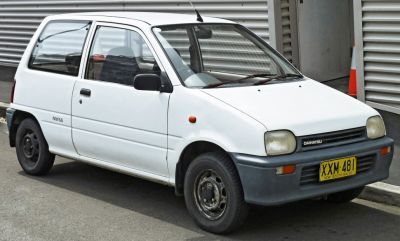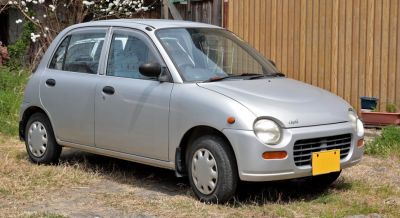 1992 Subaru Vivio Dimensions, Size & Specs
1992 Subaru Vivio Dimensions, Size & SpecsMeasurements of the 1992 Subaru Vivio, engineered for optimal performance and comfort
| Dimensions | |
|---|---|
| Length: | 3295 mm129.7 in10.8 ft |
| Width: | 1395 mm54.9 in4.6 ft |
| Height: | 1375-1385 mm54.1-54.5 in4.5-4.5 ft |
| Trunk Capacity: | 95-105 liter3.4-3.7 cu ft |
| Trunk Capacity (Max): | 835 liter29.5 cu ft |
| Weight Specifications | |
| Curb Weight: | 625-700 kg1378-1543 lbs |
| Maximal permitted Weight: | 1110 kg2447 lbs |
| Tire Specifications | |
| Rims Size: | 12-inch rims:
|
| Tire Size: |
|
The Subaru Vivio (1992-1998) is a classic kei hatchback manufactured by Subaru, renowned for its ultra-compact dimensions and efficient design tailored for urban mobility. Measuring just 3295 mm (129.7 in) in length and 1395 mm (54.9 in) in width, the Vivio is one of the smallest vehicles produced in the 1990s, making it ideal for navigating tight city streets and parking in limited spaces. Its height ranges from 1375 to 1385 mm (54.1 to 54.5 in), giving it a slightly elevated stance relative to its footprint. Weighing between 625 and 700 kg (1378 to 1543 lbs) curb weight, the vehicle maintains a light and agile character, enhancing fuel efficiency and maneuverability.
The Subaru Vivio offers a luggage capacity starting at 95 liters (3.4 cubic feet), which expands significantly to 835 liters (29.5 cubic feet) when the rear seats are folded down, providing flexible cargo options for daily errands or small trips. This hatchback rides on 12-inch rims (4J x 12) paired with tires sized 145/70 R12, contributing to its nimble handling and comfortable ride quality.
Produced from 1992 to 1998, the Vivio embodies the kei car philosophy — compact size, lightweight construction, and practical utility — making it a beloved choice for city dwellers and those seeking an economical yet reliable small car. Whether used as a primary vehicle or a convenient urban runabout, the Subaru Vivio remains a noteworthy example of efficient space use without sacrificing functionality.
Discover the standout features that make the 1992 Subaru Vivio a leader in its class
Have a question? Please check our knowledgebase first.
The 1992-1998 Subaru Vivio hatchback has a compact footprint ideal for city driving. Its length measures approximately 3295 mm (129.7 inches), width is 1395 mm (54.9 inches), and height ranges from 1375 mm to 1385 mm (54.1 to 54.5 inches). These dimensions make it a very small vehicle by modern standards, which helps with maneuverability and parking in tight spaces.
The curb weight of the Subaru Vivio varies slightly depending on trim and equipment but generally ranges between 625 and 700 kg (approximately 1378 to 1543 pounds). The maximum weight capacity, including passengers and payload, is rated at 1110 kg (2447 pounds), which ensures the small hatchback has adequate load handling for urban and light cargo use.
In standard configuration with rear seats in use, the Subaru Vivio provides a modest luggage capacity of 95 to 105 liters (about 3.35 to 3.71 cubic feet). When the rear seats are folded flat, available cargo space expands dramatically to 835 liters (roughly 29.5 cubic feet), allowing it to carry larger items despite its compact size.
The Subaru Vivio rolls on 4J x 12 inch rims paired with tires sized 145/70 R12. These small wheels complement the car's lightweight and compact dimensions, contributing to nimble handling and efficiency, which is typical for kei cars and small hatchbacks of its era.
The Subaru Vivio's height ranges from 1375 mm to 1385 mm (54.1 to 54.5 inches). This relatively low height keeps the vehicle aerodynamic and compact but still offers reasonable headroom inside for passengers, especially considering the car's kei car-related design priorities. The slight height variation can depend on trim levels or suspension setup.
Yes, the Subaru Vivio's compact size makes it an excellent fit for standard residential garages. Given its length of 3295 mm (about 129.7 inches or 10.8 feet) and width of 1395 mm (54.9 inches or roughly 4.6 feet), it will comfortably fit in typical single-car garages, which usually exceed 2.4 meters (8 feet) in width and 5 to 6 meters (16.4 to 19.7 feet) in length.
The 1992-1998 Subaru Vivio generation continued the tradition of small kei cars. Compared to its predecessor models, it retained similarly compact dimensions but featured modest refinements in width and height to improve interior space and comfort. These slight increases optimized usability while maintaining kei car classification standards, ensuring it remained practical and easy to drive in urban settings.
When compared with other kei cars and small hatchbacks from the early to mid-1990s, the Subaru Vivio is notably compact even within this segment. Its length of 3295 mm (129.7 inches) and narrow width of 1395 mm (54.9 inches) place it among the smaller vehicles, making it exceptionally maneuverable. Competitors like the Suzuki Alto or Daihatsu Mira share similar dimensions, but the Vivio is often praised for its efficient space utilization and light curb weight.
The compact dimensions of the Subaru Vivio lend themselves to an agile and easy driving experience, especially in crowded urban environments and narrow streets. Its length and narrow width allow for tight turning radii and simpler parking, while the low weight contributes to nimble handling dynamics. However, the smaller size also means limited interior space and cargo capacity when compared to larger vehicles, emphasizing its role as a city-focused practical vehicle.
Given its exterior dimensions, the Subaru Vivio inherently has limited interior and cargo space compared to larger hatchbacks or sedans. With only 95 to 105 liters (3.35 to 3.71 cubic feet) of luggage space with seats upright, tall or bulky items require rear seats to be folded, expanding space to 835 liters (29.5 cubic feet). Passenger space is cozy, especially for taller individuals, typical for a kei car where maximizing interior room within regulated small external dimensions is a key design challenge. It's ideal for city commuting but less suited for long trips with many passengers or large cargo.
Discover similar sized cars.

| Production: | 1990-1994 |
|---|---|
| Model Year: | 1990 |
| Length: | 3295 mm129.7 in |
| Width: | 1395 mm54.9 in |
| Height: | 1410 mm55.5 in |

| Production: | 1992-1998 |
|---|---|
| Model Year: | 1992 |
| Length: | 3295 mm129.7 in |
| Width: | 1395 mm54.9 in |
| Height: | 1395 mm54.9 in |

| Production: | 1989-1998 |
|---|---|
| Model Year: | 1990 |
| Length: | 3290 mm129.5 in |
| Width: | 1395 mm54.9 in |
| Height: | 1400-1425 mm55.1-56.1 in |

| Production: | 1997-2008 |
|---|---|
| Model Year: | 1997 |
| Length: | 3200-3350 mm126.0-131.9 in |
| Width: | 1420 mm55.9 in |
| Height: | 1400-1415 mm55.1-55.7 in |
